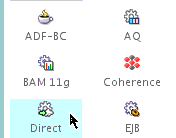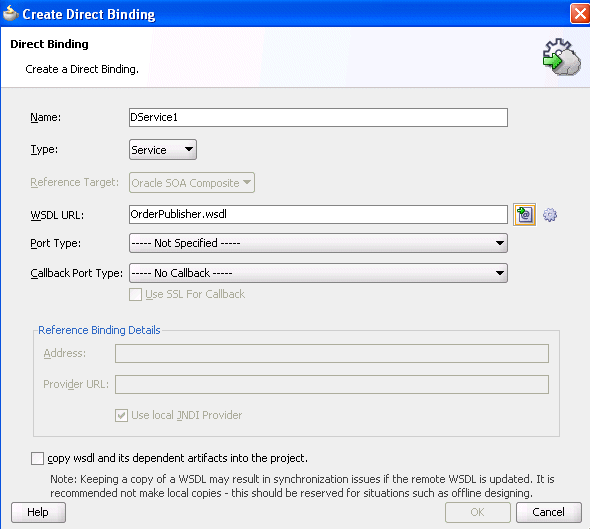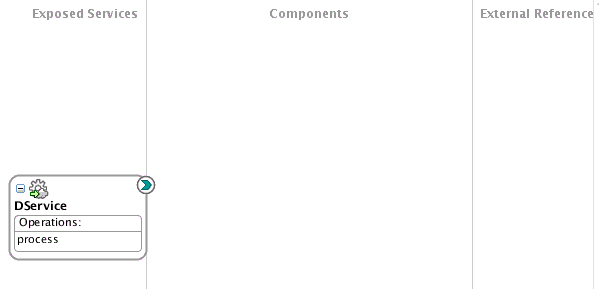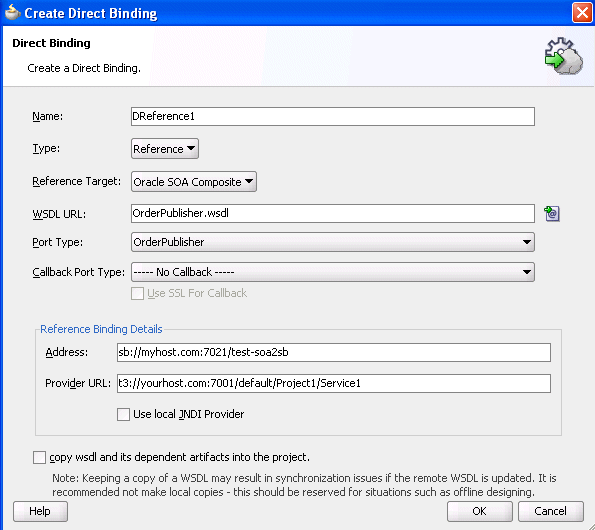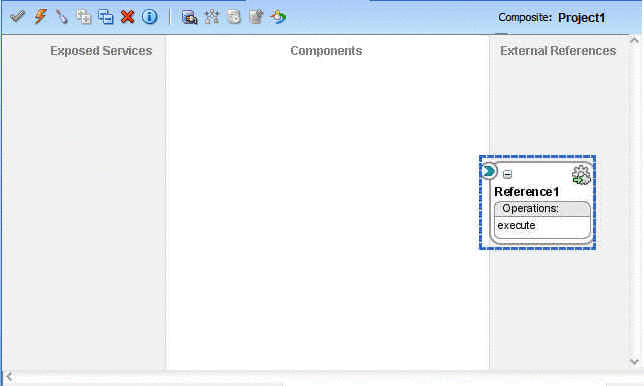38 Using Direct Binding to Invoke Composite Services
This chapter includes the following sections:
38.1 Introduction to Direct Binding
A common way to invoke a composite is to use SOAP over HTTP. This is enabled by creating a SOAP service for your composite using web service binding. However, you can also use direct binding, which provides a tighter integration alternative. Direct binding enables Java clients to directly invoke composite services, bypassing the intermediate conversion to XML required with web service binding.
Direct binding provides two types of invocation styles:
-
Inbound direct binding
The direct service binding component allows an external client to send messages using the Direct Binding Invocation API, where the Direct Binding Invocation API takes the JNDI connection parameters and creates a connection object on behalf of the client.
-
Outbound direct binding (or direct reference binding)
The direct reference binding component provides support for sending SOA messages directly to external services over a remote method invocation (RMI). These external services must implement the SOA invocation API (the same as the direct inbound invocation API).
In the case of direct outbound binding, the connection object is created with the JNDI name of the external service bean configured for the binding.
Direct binding must be associated with the interface.wsdl, providing the interface clause and, optionally, the callbackInterface clause. The associated WSDL must be imported into the composite.
The service binding component also publishes a modified version of the WSDL that advertises the direct binding.
38.1.1 Direct Service Binding Component
A sample configuration using the direct service binding component is shown in the following example:
<service name="direct2">
<interface.wsdl
interface="http://xmlns.oracle.com/asyncNonConvDocLit#wsdl.interface(asyncNonConvD
ocLit)"
callbackInterface="http://xmlns.oracle.com/asyncNonConvDocLit#wsdl.interface(async
NonConvDocLitCallback)" xmlns:ns="http://xmlns.oracle.com/sca/1.0"/>
<binding.direct/>
</service>38.1.2 Direct Reference Binding Component
The direct reference binding component requires the following information to connect to a user-provided SOA invoker:
-
Properties:
A set of properties that defines the
DirectConnectionfor the end service (seeoracle.soa.management.facade.Locator). -
ConnectionFactoryclass name (seeoracle.soa.management.facade.Locator).The
ConnectionFactoryclass must implement theoracle.soa.api.invocation.DirectConnectFactoryinterface.If the
ConnectionFactoryclass name is not specified, the defaultoracle.soa.api.JNDIDirectConnectionFactoryis used. To use the default connection factory, you must supply the lookup name for the EJB. -
Address used by the external service:
This address value is not processed by the binding component, but is passed on to the service bean during invocation.
-
addressingVersion(optional):The default addressing version used is
2005/08. -
useSSLForCallback:Use a secure socket layer (SSL) for the callback JNDI connection. If this flag is set to
true, then the WS-AddressingreplyToheader instructs the service to call back at an SSL JNDI port.
A sample configuration is shown in the following example:
<reference name="HelloReference" ui:wsdlLocation="HelloService.wsdl"> <interface.wsdl interface="http://hello.demo.oracle/#wsdl.interface(HelloInterface)"/> <binding.direct connection-factory="oracle.soa.api.JNDIDirectConnectionFactory" addressingVersion="http://www.w3.org/2005/08/addressing" address="soadirect://syncOut" useSSLForCallback="false"> <property name="oracle.soa.api.invocation.direct.bean">MyDirectTestServiceBean#directEjb.Tes tInvoker</property> <property name="java.naming.factory.initial">weblogic.jndi.WLInitialContextFactory</property > <property name="java.naming.provider.url">t3://@host:@port</property> </binding.direct> </reference>
The direct binding components support both synchronous and asynchronous invocation patterns. Figure 38-1 describes a sample synchronous invocation pattern and Figure 38-2 describes a sample asynchronous invocation pattern.
Figure 38-1 Sample Synchronous Invocation Patterns
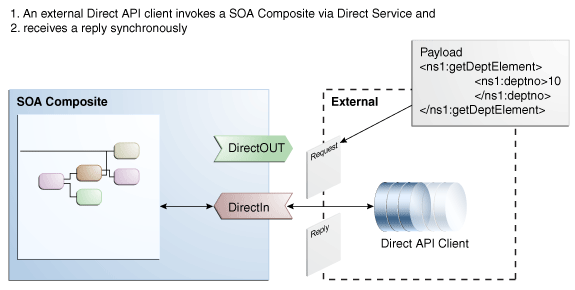
Description of "Figure 38-1 Sample Synchronous Invocation Patterns"
Figure 38-2 Sample Asynchronous Invocation Pattern
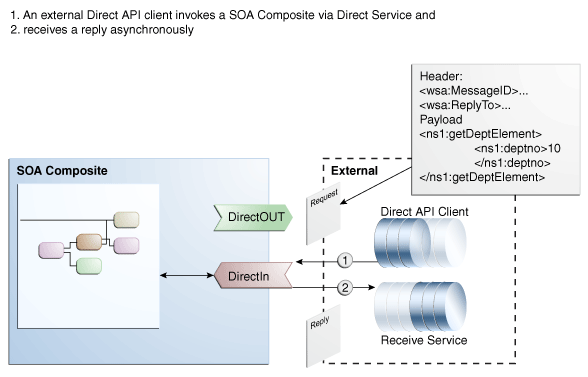
Description of "Figure 38-2 Sample Asynchronous Invocation Pattern"
38.2 Introduction to the Direct Binding Invocation API
The different packages used in the Direct Binding Invocation API are as follows:
-
oracle.soa.management.facade.LocatorThe
oracle.soa.management.facade.Locatorinterface exposes a method,createConnection, which returns a direct connection. TheLocatorexposes the method shown in the following example for returning theDirectConnection.import java.util.Map; public interface DirectConnectionFactory { DirectConnection createDirectConnection(CompositeDN compositeDN, String serviceName) throws Exception;You can use the
LocatorFactoryimplementation to obtain theDirectConnection, as shown in the following example:Hashtable jndiProps = new Hashtable(); jndiProps.put(Context.PROVIDER_URL, "t3://" + hostname + ':' + portname + "/soa-infra"); jndiProps.put(Context.INITIAL_CONTEXT_FACTORY,"weblogic.jndi.WLInitialContextFactory"); jndiProps.put(Context.SECURITY_PRINCIPAL,"weblogic"); jndiProps.put(Context.SECURITY_CREDENTIALS,"welcome1"); jndiProps.put("dedicated.connection","true"); Locator locator = LocatorFactory.createLocator(jndiProps); CompositeDN compositedn = new CompositeDN(domainName, compositename, version); String serviceName = "HelloEntry"; return locator.createDirectConnection(compositedn, serviceName); -
oracle.soa.api.invocation.DirectConnectionThe
DirectConnectioninterface invokes a composite service using direct binding. For more information, see Java API Reference for Oracle SOA Suite Infrastructure Management. -
oracle.soa.api.message.MessageThe
Messageinterface encapsulates the data exchanged. For more information, see Java API Reference for Oracle SOA Suite Infrastructure Management.
38.2.1 Synchronous Direct Binding Invocation
Direct binding also supports the synchronous direct invocation with use of the method shown in the following example:
<T> Message<T> request(String operationName, Message<T> message)
throws InvocationException, FaultException38.2.2 Asynchronous Direct Binding Invocation
Asynchronous invocation relies on the WS-Addressing headers set on the message instance. All headers must adhere to the WS-Addressing specification.
The Direct Binding Invocation API allows the clients to specify the WS-Addressing ReplyTo SOAP header to communicate a destination by which they can receive responses.
Note:
The supported addressing version includes:
An example of the WS-Addressing header used for asynchronous invocation is shown below:
<wsa:MessageID>D6202742-D9D9-4023-8167-EF0AB81042EC</wsa:MessageID>
<wsa:ReplyTo xmlns:wsa="http://www.w3.org/2005/08/addressing">
<wsa:Address>sb://testserver:9001/callback</wsa:Address>
<wsa:ReferenceParameters>
<soa:callback xmlns:soa="http://xmlns.oracle.com/soa/direct"
connection-factory="mytest.MyDirectionConnectionFactory">
<soa:property name="oracle.soa.api.invocation.direct.bean"
value="myTest.MyDirectConnectionBean"/>
<soa:property name="java.naming.provider.url" value="t3://test:8001"/>
<soa:property name="java.naming.factory.initial"
value="weblogic.jndi.WLInitialContextFactory"/>
</soa:callback>
</wsa:ReferenceParameters>
</wsa:ReplyTo>Note:
You must qualify the callback and its property elements properly with the SOA direct namespace.
The direct binding component is responsible for parsing the addressing headers set on the message instance. In this example, there are two headers: wsa:MessageID and wsa:ReplyTo. The service binding component makes the following properties available for the internal SOA components:
-
replyToAddress=sb://testserver:9001/callback -
replyToReferenceParameter:element of WSA:ReferenceParameters
38.2.3 Required JAR Files for Compiling and Running the Direct Binding Java Client Code
The following JAR file is required for compiling the direct binding Java client code:
-
$FMWHOME/soa/soa/modules/oracle.soa.mgmt_11.1.1/soa-infra-mgmt.jar
The following JAR files are required for running the direct binding Java client code:
-
$FMWHOME/wlserver/server/lib/wlthint3client.jar -
$FMWHOME/soa/soa/modules/oracle.soa.fabric_11.1.1/oracle-soa-client-api.jar
38.2.4 SOA Direct Address Syntax
The service paths used with the Direct Binding Invocation API follow the SOA direct address pattern:
-
soadirect:/CompositeDN/serviceName, whereCompositeDNstands for composite distinguished name
In the SOA direct address, the CompositeDN has the following form (label is optional):
domainName/compositeName[!compositeVersion[*label]]
38.2.5 SOA Transaction Propagation
Direct binding supports the SOA transaction propagation feature. You can invoke this feature from the client in the following ways:
-
Begin the Java transaction from the client and, after performing all the database operations, perform a commit. You should commit the database operations after a successful commit from the client side.
-
Begin the Java transaction from the client side. If a fault is thrown during any operation in the SOA composite, then roll back the transaction from the client side. This rolls back all the database operations.
38.3 Exception Handling with SOA Direct Transport
<wsdl:portType name="MyServicePortType">
<wsdl:operation name="Execute">
<wsdl:input message="exp:ExecuteRequestMsg"/>
<wsdl:output message="exp:ExecuteResponseMsg"/>
<wsdl:fault name="executeFault" message="exp:ExecuteFaultMsg"/>
<wsdl:fault name="genericFault" message="exp:GenericFaultMsg"/>
</wsdl:operation>
</wsdl:portType><soapenv:Envelope xmlns:soapenv="http://schemas.xmlsoap.org/soap/envelope/">
<soapenv:Body>
<soapenv:Fault xmlns:ns0="http://www.example.org/MyService">
<faultcode>ns0:genericFault</faultcode>
<faultstring/>
<faultactor/>
<detail>
<GenericFault xmlns="http://www.example.org/FaultInfo">
<FaultInfo>
<ErrorDescription>Error - soap1.1</ErrorDescription>
</FaultInfo>
</GenericFault>
</detail>
</soapenv:Fault>
</soapenv:Body>
</soapenv:Envelope> <soap:Envelope xmlns:soap="http://www.w3.org/2003/05/soap-envelope">
<soap:Header xmlns:exem="http://www.example.org/MyService"/>
<soap:Body xmlns:exem="http://www.example.org/MyService">
<soap:Fault>
<soap:Fault>
<soap:Value>soap:Receiver</soap:Value>
<soap:Subcode>
<soap:Value xmlns:ns1=" soap:value>"="" target="_blank">http://www.example.org/MyService">ns1:genericFault</soap:Value>
</soap:Subcode>
</soap:Code>
<soap:Reason>
<soap:Text xml:lang="pt">Failure calling partner.</soap:Text>
</soap:Reason>
<soap:Node>...</soap:Node>
<soap:Detail>
<err:GenericFault xmlns:err="http://www.example.org/FaultInfo">
<err:FaultInfo>
<err:ErrorDescription>Error Desc</err:ErrorDescription>
</err:FaultInfo>
</err:GenericFault>
</soap:Detail>
</soap:Fault>
</soap:Body>
</soap:Envelope>38.4 Invoking a SOA Composite Application in Oracle JDeveloper with the Invocation API
The Direct icon in the Components window in Oracle JDeveloper, as shown in Figure 38-3, provides support for exchanging SOA messages with SOA over RMI.
Oracle JDeveloper supports creating a direct service binding and a direct reference binding that invokes either an Oracle Service Bus or another SOA composite.
Note:
For a client to invoke composite services over direct binding, its class path must include both soa-infra-mgmt.jar, wlthint3client.jar, and oracle-soa-client-api.jar.
For more information about the Direct Binding Invocation API, see Introduction to the Direct Binding Invocation API.
38.4.1 How to Create an Inbound Direct Binding Service
You can invoke a SOA composite application using the Direct icon in the Components window in Oracle JDeveloper.
To create an inbound direct binding service:
38.4.2 How to Create an Outbound Direct Binding Reference
You can create an outbound direct binding reference using the Direct icon in the Components window in Oracle JDeveloper to either invoke a SOA composite application or an Oracle Service Bus.
Note:
When Oracle SOA Suite and Oracle Service Bus are in different domains, you must enable trust between the domains.
To create an outbound direct binding reference:
38.4.3 How to Set an Identity for J2SE Clients Invoking Direct Binding
A user identity can be established when authenticating to the server during the process of JNDI lookup by passing the JNDI security credential, as shown in the following example:
public static void main(String[] args) throws Exception {
String operation = "process";
// This is the request message XML
String ns = "http://xmlns.oracle.com/DirectBinding_jws/EchoBPEL/BPELProcess1";
String payloadXML = "<ns1:process xmlns:ns1=\"" + ns + "\">\n" +
" <ns1:input>wew</ns1:input>\n" +
"</ns1:process>";
String serviceAddress = "soadirect:/default/EchoBPEL!1.0/DService1";
// Specify the direct binding connection properties
Map<String, Object> props = new HashMap<String, Object>();
props.put(Context.INITIAL_CONTEXT_FACTORY, "weblogic.jndi.WLInitialContextFactory");
props.put(Context.PROVIDER_URL, "t3://" + hostname + ':' + portname);
props.put(Context.SECURITY_PRINCIPAL,username);
props.put(Context.SECURITY_CREDENTIALS, password);
// Create the direct binding connection, using those context properties
DirectConnectionFactory factory = JNDIDirectConnectionFactory.newInstance();
try {
DirectConnection dc = factory.createConnection(serviceAddress, props);
// Parse the XML request message
DocumentBuilderFactory dbf = DocumentBuilderFactory.newInstance();
Document doc =
dbf.newDocumentBuilder().parse(new InputSource(new StringReader(payloadXML)));
// Prepare the payload for inclusion in the Message object
Map<String, Element> payload = new HashMap<String, Element>();
payload.put("payload", doc.getDocumentElement());
Message<Element> request = XMLMessageFactory.getInstance().createMessage(payload);
Message<Element> response = dc.request(operation, request);
} finally {
dc.close();
}
}38.4.4 What You May Need to Know About Invoking SOA Composites on Hosts with the Same Server and Domain Names
If one SOA composite application invokes another SOA composite application on another host through direct binding, and both composites are on hosts with the same server name and domain name, the invocation fails.
This is because the Oracle WebLogic Server transaction subsystem requires the domain names and server names to be different for transaction management to work properly. The transaction subsystem uses these names to track the location of a server related to a transaction. If the two servers in the invocation have the same name, the transaction subsystem can mistakenly confuse the two servers.
Ensure that you use hosts with separate server names and domain names.
38.5 Samples Using the Direct Binding Invocation API
This section provides some examples of how the API is used. It describes how the connection parameter can invoke SOA composite applications over direct binding and how message objects can be modified to invoke a direct binding invocation.
// The JNDIDirectConnectionFactory can be used to establish SOA instance
// connections for exchanging messages over the direct binding.
DirectConnectionFactory dcFactory = JNDIDirectConnectionFactory.newInstance();
// Connections are created based on the configuration, which is a map of standard
// naming properties, which will be used for the underlying connection lookup.
Map<String, Object> properties = new HashMap<String, Object>();
properties.put(Context.INITIAL_CONTEXT_FACTORY, jndi.WLInitialContextFactory");
properties.put(Context.PROVIDER_URL, "t3://HOST:PORT");
properties.put(Context.SECURITY_PRINCIPAL, USERNAME);
properties.put(Context.SECURITY_CREDENTIALS, PASSWORD);
DirectConnection conn =
dcFactory.createConnection("soadirect:/default/MyComposite!1.0/MyService",
properties);// Messages are created using the MessageFactory
// Message objects are subsequently modified to be used for an invocation.
Message<Element> request = XMLMessageFactory.getInstance().createMessage();
// Define a Map of WSDL part names to matching XML Element objects
Map<String, Element> partData;
Payload<Element> payload = PayloadFactory.createXMLPayload(partData);
request.setPayload(payload);
// One-way invocation
conn.post("onewayoperation", request);
// Request-reply invocation
Message<Element> response = conn.request("requestreplyoperation", request);Hashtable jndiProps = new Hashtable();
jndiProps.put(Context.PROVIDER_URL, "t3://" + HOST + ':' + PORT);
jndiProps.put(Context.INITIAL_CONTEXT_FACTORY,
"weblogic.jndi.WLInitialContextFactory");
jndiProps.put(Context.SECURITY_PRINCIPAL,USERNAME);
jndiProps.put(Context.SECURITY_CREDENTIALS, PASSWORD);
Locator locator = LocatorFactory.createLocator(jndiProps);
CompositeDN compositedn = new CompositeDN(domainName, compositename, version);
String serviceName = "HelloEntry";
DirectConnection conn = locator.createDirectConnection(compositedn, serviceName);